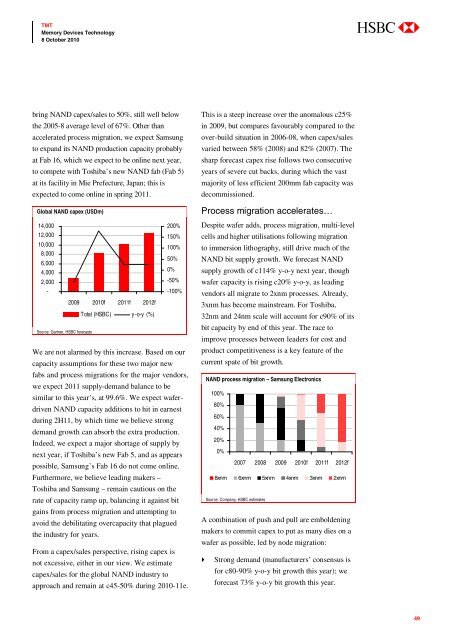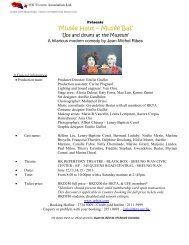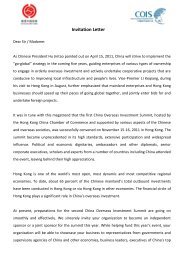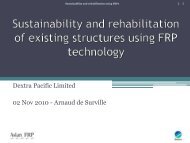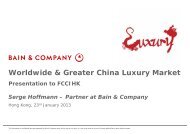You also want an ePaper? Increase the reach of your titles
YUMPU automatically turns print PDFs into web optimized ePapers that Google loves.
TMT<br />
<strong>Memory</strong> Devices Technology<br />
8 October 2010<br />
abc<br />
bring NAND capex/sales to 50%, still well below<br />
the 2005-8 average level of 67%. Other than<br />
accelerated process migration, we expect Samsung<br />
to expand its NAND production capacity probably<br />
at Fab 16, which we expect to be online next year,<br />
to compete with Toshiba’s new NAND fab (Fab 5)<br />
at its facility in Mie Prefecture, Japan; this is<br />
expected to come online in spring 2011.<br />
Global NAND capex (USDm)<br />
14,000<br />
12,000<br />
10,000<br />
8,000<br />
6,000<br />
4,000<br />
2,000<br />
-<br />
Source: Gartner, HSBC forecasts<br />
2009 2010f 2011f 2012f<br />
Total (HSBC) y-o-y (%)<br />
200%<br />
150%<br />
100%<br />
50%<br />
0%<br />
-50%<br />
-100%<br />
We are not alarmed by this increase. Based on our<br />
capacity assumptions for these two major new<br />
fabs and process migrations for the major vendors,<br />
we expect 2011 supply-demand balance to be<br />
similar to this year’s, at 99.6%. We expect waferdriven<br />
NAND capacity additions to hit in earnest<br />
during 2H11, by which time we believe strong<br />
demand growth can absorb the extra production.<br />
Indeed, we expect a major shortage of supply by<br />
next year, if Toshiba’s new Fab 5, and as appears<br />
possible, Samsung’s Fab 16 do not come online.<br />
Furthermore, we believe leading makers –<br />
Toshiba and Samsung – remain cautious on the<br />
rate of capacity ramp up, balancing it against bit<br />
gains from process migration and attempting to<br />
avoid the debilitating overcapacity that plagued<br />
the industry for years.<br />
From a capex/sales perspective, rising capex is<br />
not excessive, either in our view. We estimate<br />
capex/sales for the global NAND industry to<br />
approach and remain at c45-50% during 2010-11e.<br />
This is a steep increase over the anomalous c25%<br />
in 2009, but compares favourably compared to the<br />
over-build situation in 2006-08, when capex/sales<br />
varied between 58% (2008) and 82% (2007). The<br />
sharp forecast capex rise follows two consecutive<br />
years of severe cut backs, during which the vast<br />
majority of less efficient 200mm fab capacity was<br />
decommissioned.<br />
Process migration accelerates…<br />
Despite wafer adds, process migration, multi-level<br />
cells and higher utilisations following migration<br />
to immersion lithography, still drive much of the<br />
NAND bit supply growth. We forecast NAND<br />
supply growth of c114% y-o-y next year, though<br />
wafer capacity is rising c20% y-o-y, as leading<br />
vendors all migrate to 2xnm processes. Already,<br />
3xnm has become mainstream. For Toshiba,<br />
32nm and 24nm scale will account for c90% of its<br />
bit capacity by end of this year. The race to<br />
improve processes between leaders for cost and<br />
product competitiveness is a key feature of the<br />
current spate of bit growth.<br />
NAND process migration – Samsung Electronics<br />
100%<br />
80%<br />
60%<br />
40%<br />
20%<br />
0%<br />
2007 2008 2009 2010f 2011f 2012f<br />
8xnm 6xnm 5xnm 4xnm 3xnm 2xnm<br />
Source: Company, HSBC estimates<br />
A combination of push and pull are emboldening<br />
makers to commit capex to put as many dies on a<br />
wafer as possible, led by node migration:<br />
Strong demand (manufacturers’ consensus is<br />
for c80-90% y-o-y bit growth this year); we<br />
forecast 73% y-o-y bit growth this year.<br />
49


